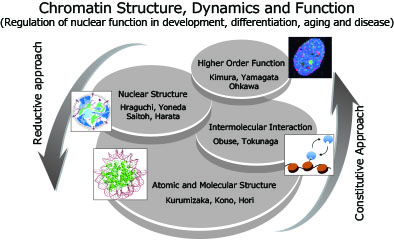Chromatin Structure and Dynamics
| Japanese Page |
 Genomic DNA, which bears the genetic information, is a huge molecule that can measure more than two meters in humans. Such a large molecule is packed into the tiny space of the cell nucleus, which has a volume of just 100 femtoliters. This high level of compaction is made possible by the formation of a molecular complex called “chromatin”. The basic protein components of the chromatin are histones that compact DNA. In the chromatin, DNA is wrapped around histones, forming a protein-DNA complex called the “nucleosome”, which has a “beads on a string” appearance. The nucleosome associates with other proteins and RNAs, which folds into a higher-order structure. While chromatin effectively compacts DNA, the compacted form is not favorable for various DNA metabolisms, such as replication, transcription, and recombination, because enormous energy is required to unwind the DNA from the chromatin. Organisms accomplish this seemingly formidable task by dynamically changing its chromatin structure. “Chromatin dynamics” is driven by the diversification of the nucleosome structures, which involves the incorporation of histone variants, histone modifications, histone chaperones, nucleosome remodelers, chromatin binding proteins, and various non-coding RNAs. Chromatin dynamics is also controlled by interactions with the nuclear structures and the nuclear membrane including the nuclear pore complex. The aim of our research project is to elucidate the structural basis of chromatin dynamics, and propose a new concept for the mechanism of how eukaryotic organisms use genomic DNA as a carrier of genetic information.
Genomic DNA, which bears the genetic information, is a huge molecule that can measure more than two meters in humans. Such a large molecule is packed into the tiny space of the cell nucleus, which has a volume of just 100 femtoliters. This high level of compaction is made possible by the formation of a molecular complex called “chromatin”. The basic protein components of the chromatin are histones that compact DNA. In the chromatin, DNA is wrapped around histones, forming a protein-DNA complex called the “nucleosome”, which has a “beads on a string” appearance. The nucleosome associates with other proteins and RNAs, which folds into a higher-order structure. While chromatin effectively compacts DNA, the compacted form is not favorable for various DNA metabolisms, such as replication, transcription, and recombination, because enormous energy is required to unwind the DNA from the chromatin. Organisms accomplish this seemingly formidable task by dynamically changing its chromatin structure. “Chromatin dynamics” is driven by the diversification of the nucleosome structures, which involves the incorporation of histone variants, histone modifications, histone chaperones, nucleosome remodelers, chromatin binding proteins, and various non-coding RNAs. Chromatin dynamics is also controlled by interactions with the nuclear structures and the nuclear membrane including the nuclear pore complex. The aim of our research project is to elucidate the structural basis of chromatin dynamics, and propose a new concept for the mechanism of how eukaryotic organisms use genomic DNA as a carrier of genetic information.




